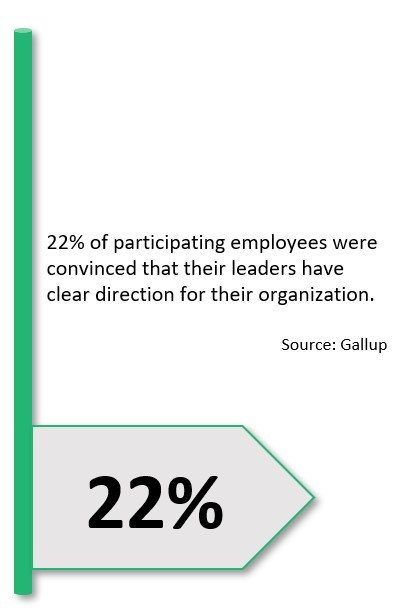
As you work on technology projects, do you doubt the very foundations upon which your strategic initiatives are built? A recent Bridges Business Consulting report reveals that only 2% of leaders are confident that they can achieve 80% to 100% of their strategic objectives. This prompts us to ask: What drives this doubt? How can you overcome it and embark on a journey of discovery that propels you towards successful tactical execution? In this article, we will discover the importance of tactical plans, clarify the difficulties that frequently affect their ideation, and elaborate on how predictive intelligence tools can skillfully reduce the concerns complicating your tactical planning efforts.
The Significance of Tactical Plans
Tactical plans form an integral bridge between your strategic vision and operational execution. They translate the grand aspirations of strategic goals into actionable steps, aligning technology project resources, teams, and timelines to create a clear delivery roadmap for achieving short-term objectives. Yet, the road to success is paved with challenges that often cast shadows of doubt.
Tactical Planning: A Definitive Perspective Before delving into the challenges and solutions, it is crucial to define your tactical planning steps. In essence, tactical planning involves developing detailed and concrete steps to execute a larger strategic plan. It is the process of breaking down strategic goals into manageable project tasks and allocating resources effectively to ensure successful technology project execution. The link between strategic and tactical planning is a vital one since strategic goals remain unfulfilled if your tactical plans are not implemented well.
Before delving into the challenges and solutions, it is crucial to define your tactical planning steps. In essence, tactical planning involves developing detailed and concrete steps to execute a larger strategic plan. It is the process of breaking down strategic goals into manageable project tasks and allocating resources effectively to ensure successful technology project execution. The link between strategic and tactical planning is a vital one since strategic goals remain unfulfilled if your tactical plans are not implemented well.
The Doubts and Challenges in Tactical Plans
Tactical planning is not without its trials and tribulations. Organizations grapple with a myriad of uncertainties, which can potentially jeopardize the realization of project benefits and overall project value. Only 22% of employees participating in a recent Gallup study were convinced that their leaders have clear direction for their organization goals. This statistic highlights the pervasive nature of doubt in tactical planning, especially when faced with unavoidable roadblocks.
Risk Mitigation: A Race Against Time
One of the primary challenges that plague tactical planning is the timely mitigation of risks. Do you frequently race against time, struggling to identify and address risks that could derail your projects? In an environment where project landscapes can change rapidly, hesitation in risk management can amplify doubt and hinder progress.
Skepticism on Project Fulfillment
Organizations often harbor doubts about whether their technology projects will indeed fulfill the tactical goals laid out. Do you feel the same? These doubts can arise due to inadequate project alignment, unclear communication, or a lack of confidence in the chosen project management methodologies. Such skepticism can lead to half-hearted execution and subpar project outcomes.
Strategic Tactical and Operational Planning Integration
To combat skepticism and bridge the gap between strategic and tactical plans, you must focus on integrating not only strategic and tactical plans but also operational plans. This alignment ensures that each level of planning supports the others, fostering a unified approach towards project execution.
The Promise of Predictive Intelligence
Predictive intelligence emerges as an accelerator for improvement and success in the field of tactical planning. You can go beyond instincts and proactively predict changes in the business landscape by leveraging the potential of data-driven foresight. Decision-makers are given the foresight by predictive intelligence to recognize developing trends, potential disruptions, and customer behavior patterns, allowing them to adjust tactical strategies when required. In addition to improving adaptability, this combination of strategic intent and predictive capacity well-equips your business to harness opportunities and address challenges. Following are the ways you can benefit from AI-assisted tools:
Correct Project Recommendations
AI-driven recommendations can provide you with data-backed insights on technology project strategies, resource allocation, and risk mitigation. By harnessing the power of previous project data and predictive analytics, AI tools can recommend the most suitable course of action, guiding you away from doubt-induced tactical hesitations.
Methodology Validation for Project Progress
AI-assisted platforms can also act as impartial validators of methodologies. Through continuous monitoring and analysis of project progress, these tools can uncover whether selected methodologies are enabling or inhibiting project advancement for strategic and tactical planning. This discovery-driven approach empowers you to make informed adjustments and embrace strategies that bolster your tactical endeavors.
Quantitative Project Performance Measurement
Measuring project performance based on relevant key performance indicators (KPIs) and metrics is essential for assessing your tactical plan success. Predictive intelligence tools can streamline this process by automating data collection, analysis, and reporting, enabling you to make data-driven project delivery decisions and align tactical plans with strategic objectives.
Enhanced Collaboration
Doubts and miscommunications often thrive in siloed project environments. AI-based collaboration tools facilitate seamless communication and knowledge-sharing among your project team members, breaking down barriers and fostering a culture of collaboration that supports tactical execution.
Embracing Discovery: A Unified Approach
61% of respondents in an Economist study revealed that their organizations struggle to bridge the gap between strategy-making and day-to-day technology project implementation. However, amidst doubt and discovery, you must adopt a unified approach to overcome the challenges that hinder tactical plan implementation. The foundation of success lies in proactive project risk mitigation, robust alignment of strategic, tactical, and operational plans, and the integration of AI-based tools that bring forward new dimensions of efficiency and collaboration.
Tactical Planning in Management
Effective tactical planning requires a harmonious blend of leadership and management. While leaders set the strategic direction, your managers are responsible for translating these aspirations into actionable steps. This symbiotic relationship ensures that your tactical plans not only align with strategic goals but also adapt to the ever-changing project landscape.
A Roadmap to Triumph
As organizations continue to grapple with the complexities of devising effective tactical plans, the imperative to mitigate failures and setbacks looms ever larger. Since these plans propel your business forward, you must equip yourself with modern tools capable of advancing the decision-making process. One such solution is TrueProject. Through the strategic deployment of regular assessments and surveys directed at stakeholders throughout the organization, the AI-based solution cultivates a rounded understanding of technology project dynamics. This holistic insight not only informs you of potential challenges but also highlights areas for optimization. The dynamic dashboards in TrueProject offer an objective visualization of project progress in the organization. This 360-degree panoramic view helps you make informed and precise business decisions. As you harness the predictive prowess of TrueProject, the execution of tactical plans becomes an orchestrated symphony, resonating with assurance and foresight.
More information on TrueProject can be found at: TrueProjectInsight.com
 About the Author
About the Author
Serving as the CEO at TrueProject, Tom Villani plays a major role in shaping the company's strategic direction, driving growth, and fostering a culture of innovation. Prior to his role at TrueProject, Tom worked as the Senior Vice President, Digital Innovation of CAI, Vice President of Global Alliances and Partners at Hitachi Vantara, and key senior executive roles with Information Builders, MicroStrategy and AT&T. Tom also serves in advisory board capacities in the areas of Big Data and IoT.
Endnotes
- Indeed. “What Is Tactical Planning? Definition and Benefits.” June 25, 2022. https://www.indeed.com/career-advice/career-development/tactical-planning
- Jackson, Ted. “50+ Eye-Opening Strategic Planning Statistics.” ClearPoint Strategy, April 14, 2023. https://www.clearpointstrategy.com/blog/strategic-planning-statistics
- Richards, Leigh. “Challenges of Strategic Planners.” https://smallbusiness.chron.com/challenges-strategic-planners-4609.html
- Watts, Shelby. “Tactical Solutions to Project Management Challenges in an Unstable Economy.” The Harvest Blog, June 16, 2023. https://www.getharvest.com/blog/project-management-challenges-in-an-unstable-economy





